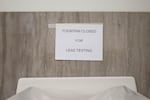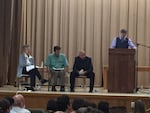
A sign hangs over a closed-off drinking fountain at Lleweyn Elementary School in Southeast Portland. Portland Public Schools shut off drinking water May 27. The district is distributing free bottled water to students.
Bradley W. Parks / OPB
Portland Public Schools Chief Operating Officer Tony Magliano sent a memo Wednesday to school board members outlining work that the district has done over the last 12 years to mitigate lead problems that were found in district water.
That announcement is in part a response to media reports that dozens of schools found elevated lead levels, particularly between 2010 and 2012, and no notice was sent to parents.
The so-called "work list" is a surprising revelation, coming a day after Portland Public Schools officials told a community meeting that learning how problems were responded to would fall to a team of outside investigators, hired by Superintendent Carole Smith and the school board.
District spokeswoman Christine Miles said the 261-page spreadsheet that's been published by multiple media outlets is only part of a larger database the district has maintained to track lead and copper in school drinking water. The spreadsheet Magliano has published includes the work list that details what steps the district did in response to the elevated lead findings.

In this May 31, 2016 photo, Portland officials listen as parents voice objections to recent revelations of lead found in school drinking water. From left, Superintendent Carole Smith, Portland Public Schools Board of Directors Chair Tom Koehler, PPS Chief Operating Officer Tony Magliano and Portland-area State Representative Rob Nosse (standing).
Rob Manning / OPB
"After reviewing the entire database, we have found that, of the locations where the testing levels exceeded the EPA action level, the data indicates that remediation actions were taken (such as filters installed, fixtures replaced, or signage posted) at over 140 locations," Magliano wrote to board members. "The data did not indicate remediation in 7 fixtures in 7 different schools."
The seven specific fixtures listed in a document labeled in part No Verified Mitigation include drinking fountains at Applegate Elementary School (now home to a Head Start program for pre-school children), Jackson Middle School, Vernon K-8 and Whitman Elementary School. Magliano's documents also show unmitigated lead in a kitchen sink at Peninsula Elementary, and fixtures at two schools that have been closed for demolition: Faubion School and Franklin High.
Of the sites where Portland Public couldn't confirm mitigation, the highest lead level was 130 lead parts per billion — about 10 times the district's established level — at a drinking fountain at Vernon K-8.
The list includes work as recent as March 2016 — when steps were taken to mitigate high lead levels at Creston and Rose City Park schools, and as long ago as fall 2004, when Astor Elementary had a bubbler replaced.
Related: Lead In The Water: How We Got Here
Portland Public Schools also released a 19-page summary of about 1,000 lead test results. PPS has said that it addresses fixtures that show at least 15 parts per billion of lead. Some parents have said the district should use a more rigorous standard. The lengthy "Lead Mitigation Verification List" shows numerous fixtures that tested between 10 and 14 parts per billion — and therefore weren't addressed.
Miles said Superintendent Smith is calling for new rounds of testing to begin as soon as possible after students leave school for the summer, June 9. Miles has also promised that the district will publish new results as quickly as the district gets them.
